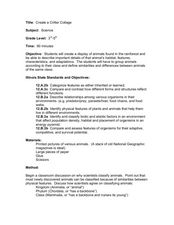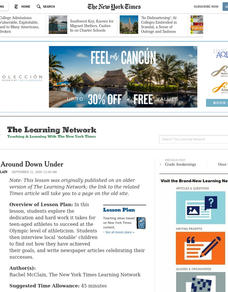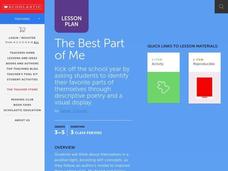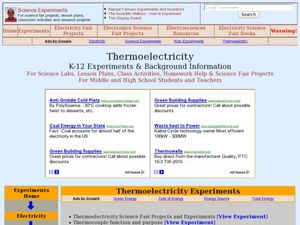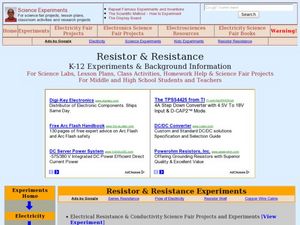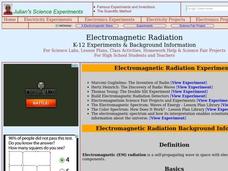Association of American Geographers
Project GeoSTART
Investigate the fascinating, yet terrifying phenomenon of hurricanes from the safety of your classroom using this earth science unit. Focusing on developing young scientists' spacial thinking skills, these lessons engage...
Teach Engineering
Preconditioning Balloons: Viscoelastic Biomedical Experiments
What does stretching a balloon have to do with equilibrium? Groups explore preconditioning by stretching a balloon to a point of equilibrium. They then measure the amount of force required to stretch the balloon to the same point several...
Science Matters
Renewable and Nonrenewable Resources
Did you know there are at least 12 different energy sources? Scholars apply their knowledge about the different types of energy as they sort energy sources by renewable and nonrenewable. Then they pick one from each section to...
Curated OER
Create a Critter Collage
Students create a collage. In this animal classification lesson, students discuss why and how scientists classify animals. Students view pictures of different animals and decide which class each animal belongs to. Students compare...
The New York Times
Kidding Around Down Under
After reading an article, "From an Alternate to a 'Miracle Kid' in a Flash," youngsters discuss the kind of commitment required for a teenager to become an Olympic athlete. A variety of activities is suggested, and the popular topic...
Curated OER
Sports Screeners
Students watch videos to discover the amount of physical activity in film and television. They present their findings to the class after viewing a film. They discuss how perceptions in films can influence young people.
Curated OER
What a Relief Map
Students create a map using cookie dough. In this geography lesson, students research the physical features of a country, draw a diagram and design and create a map out of cookie dough.
Curated OER
Best Part of Me
Students determine a positive physical feature of themselves. They participate in an online writer's workshop and write descriptive poem about their favorite feature. They create a display of poetry and pictures.
Curated OER
Magnetic Field
Students explore how compass and Gauss meter detect a magnetic field. In this physics lesson, students build their own Gauss meter and sensor based on given procedure. They cite real world applications of magnetism.
Curated OER
Science Lessons for Grade 11
Students explore different activities in biology, physics and chemistry. In this science instructional activity, students examine chromosomes using a microscope and explain their significance in sustaining life on Earth. They investigate...
Curated OER
Introduction to Electric Circuits
High schoolers explore using a circuit board in this physics lesson. They will analyze current and battery set up on a circuit board. Teachers check the board before the students experiment.
Curated OER
Thermoelectricity
Students conduct a series of experiments on thermoelectricity. For this physics lesson, students investigate how thermocouple works. They determine the voltage generated when different conductive materials are held at different...
Curated OER
Battery Charger
Students explain how battery chargers work. In this physics lesson, students discuss the two main ways that vehicles get charged. They build their own battery charger.
Curated OER
Homopolar Motor Experiments
Students construct a homopolar motor following certain procedures. In this physics lesson, students explain how generators and motors work. They compare and contrast the characteristics of both.
Curated OER
Stepper Motor
Learners compare a stepper motor from a traditional motor. In this physics lesson, students summarize how it works. They build their own stepper motor and explore its uses.
Curated OER
Galvanometers
Students construct their own galvanometer. In this physics lesson, students explain how it is used to detect electric current. They conduct an experiment to measure how much electricity flows through the circuit.
Curated OER
Resistor and Resistance
Students explore electrical resistance through various experiments. In this physics lesson, students calculate resistance using a mathematical formula. They explain how colors identify the resistance value of a resistor.
Curated OER
Graphing Your Motion with Vernier LabQuests
Seventh graders create motion graphs using a motion sensor. In this physics lesson, 7th graders match the graph shown by moving their body. They relate the slope to the way they moved.
Curated OER
Electromagnetic Radiation
Young scholars explore the nature of electromagnetic spectrum through a series of experiments. In this physics lesson, students determine how light behaves under certain circumstances. They explain how humans perceive colors.
Curated OER
So Fast! So Slow!
Fifth graders give examples of objects that move slow and fast. In this physics lesson, 5th graders rank animals according to how quickly they move. They create a bar graph of organisms versus rates of speed.
Curated OER
Magnetic Levitation
Students conduct a series of experiments on magnetic levitation. In this physics lesson, students discover how Maglev trains operate. They explain how magnetism make even simple objects levitate.
Curated OER
Electromagnets
High schoolers conduct a series of experiments on electromagnets. In this physics lesson, students build their own electromagnet and explain how it works. They determine the factors that affect its strength.
Curated OER
Lenz's Law
High schoolers conduct a series of experiments on electromagnetic induction. In this physics lesson, students apply the right hand rule to determine the current direction and electromotive force. They test Lenz's and Faraday's law by...
Curated OER
Reed Switch
Students build simple electromagnetic reed switch motors. In this physics lesson, students explain how it works. They cite real world applications of reed switches and relays.



